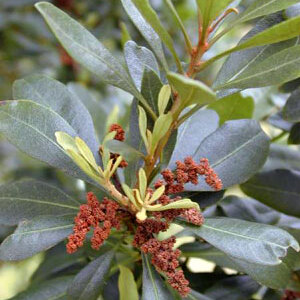Trees or shrubs, evergreen or deciduous, monoecious or dioecious, aromatic, often with resinous, peltate glands. Leaves alternate, simple, pinnately veined, entire to irregularly serrate or lobed, rarely pinnatifid; stipules absent or rarely present. Flowers in spikes, usually unisexual, anemophilous, without perianth. Male flowers solitary in axil of each bract, with 2-4 bracteoles or not. Stamens 2-20, often 4-8 on receptacle at base of bract; filaments short, free or slightly united at base; anthers erect, dithecal, extrorse, dehiscing longitudinally. Female flowers solitary or 2-4 in axil of bract, usually with 2-4 bracteoles. Gynoecium of 2 carpels united into a compound and 1-loculed ovary; styles distinct or united only at base; ovule solitary, basal, erect, orthotropous. Fruit drupaceous, or nearly a nutlet, often with headlike, wax-covered papillae; endocarp hard. Seeds nearly without endosperm; embryo straight; cotyledons fleshy, plano-convex.
Monoecious or dioecious trees, shrubs or subshrubs; nitrogen-fixing root-nodules present. Leaves alternate, entire to irregularly dentate or lobed, occasionally pinnatifid, usually with aromatic resinous gland-dots. Stipules usually absent. Flowers in dense elongate or globose axillary spikes (catkins), unisexual (or some morphologically bisexual in Canacomyrica); bracts present and sometimes a pair of smaller bracteoles; perianth absent save in Canacomyrica. Male flowers: stamens 2–10(–22); filaments short, free or partially united into a column; anthers erect, 2-thecous, opening lengthwise. Female flowers: ovary sessile, 1-locular; style short with 2 slender branches; ovule 1, erect from the base, orthotropous. Fruit either dry and with attached wing-like accrescent bracteoles or a small globose or ovoid drupe densely covered with bead-like often wax-covered papillae; endocarp hard. Seed with membranous testa and little or no endosperm
Flowers in dense elongate or globose axillary spikes (catkins), unisexual (male sometimes with vestigial female parts or some morphologically bisexual in Canacomyrica); bracts present and sometimes also smaller bracteoles
Fruit either dry and with attached wing-like accrescent bracteoles or a small globose or ovoid drupe densely covered with bead-like often wax-covered papillae; endocarp hard
Leaves alternate, entire to irregularly dentate or lobed, occasionally pinnatifid, usually with aromatic resinous gland-dots; stipules usually absent
Male flowers: stamens 2–10(22); filaments short, free or partially united into a column; anthers erect, 2-thecous, opening lengthwise
Female flowers: ovary sessile, 1-locular; style short with 2 slender branches; ovule 1, erect from the base, orthotropous
Leaves alternate, simple, sometimes pinnately lobed, scaly-glandular beneath, exstipulate
Monoecious or dioecious trees, shrubs or subshrubs; nitrogen-fixing root-nodules present
Sepals and petals absent, or the female with a few sepal-like whorled bracteoles
Male flower subtended by a solitary bract: stamens 2 or more; anthers 2-celled
Female flower: ovary sessile, 1-celled; style short, 2-branched
Flowers unisexual, monoecious or dioecious, in axillary spikes
Seed with membranous testa and little or no endosperm
Seed erect, without endosperm; embryo straight
Fruit a drupe, often warted, the warts waxy
Perianth absent except in >i>Canacomyrica
Trees or shrubs, often aromatic
Ovule 1, erect, basal

